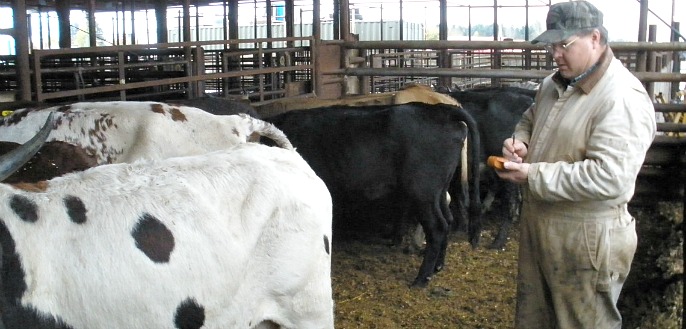
PHOTO COURTESY OF ODA
The question is, “who does this cow belong to?” The answer can be simplified if cattle owners take steps over the next several months to identify their animals. The Oregon Department of Agriculture has advice for ranchers this time of year that can help avoid headaches when cattle are rounded up and readied for market later in the season. At the heart of the matter is the value and importance of brands.
“Our brand Inspectors deal with a number of ‘mistakes’ when cattle are being presented for brand inspection,” says ODA’s Rodger Huffman, manager of the Animal Identification Program. “Inspectors are identifying more and more cattle that belong to the neighbors. We understand this is the brand inspector’s job, however, we are asking for the industry’s assistance.”
The Animal Identification Program prevents livestock theft by denying a market for stolen animals through the recording of brands and inspection of animals. Brand recording helps verify ownership, helps track disease outbreaks, and helps return lost or estray animals to their owners. There is nothing quite as effective as the old fashioned cattle brand and the work of ODA brand inspectors to help stolen or lost livestock get back to their rightful owners. But there are a number of ways producers can help themselves.
“While a brand is generally the ultimate determiner of ownership, other tools are just as important,” says Huffman. “We all know it is much more difficult to see and read brands in the winter months due to hair growth, inclement weather, and mud or manure covering brand locations. Producers can help avoid embarrassment by taking more time when handling and marking these cattle.”
Effective tools include earmarks– permanent cuts or marks in the ear of livestock– as well as ear tags, metal ID tags, and flesh marking. Ear tags should be unique in shape, color, size, or style for a geographic area. The same unique tag should be used consistently by individual producers. Flesh marking includes a fold of loose skin on the animals, such as wattles and dewlaps, that are unique to a producer’s livestock. Flesh marking and earmarks can be listed with a registered brand by ODA.
“An involved producer knows the type of markings or tags used by his neighbors or other producers in the area, and makes an effort to mark his animals with something distinctly different,” says Huffman. “As they process this year’s calf crop and prepare to turn out the cows and bulls, producers should keep these suggestions in mind. Proper use of tags and/or flesh marking is an added insurance that an animal will return home.”
Huffman’s message is timed with the production of a new calf crop this winter and the preparation of adult cattle before they are turned out for grazing in a few months.
“We’re trying to get producers to think about the process they use to identify their cattle and to do a good job so there is a better likelihood they get their animals back,” says Huffman.
One of the challenges is the prevalence of absentee owners or operations large enough to require multiple people to handle the cattle. Often times, the final sorting of livestock before they are taken to sale is by somebody who isn’t the actual owner. The identification of the cattle is not obvious to these hired hands. So an animal identification system that can be recognized and understood by all employees and family members of the operation is important.
“We are getting further away from cattle owners directly managing their land and cattle,” says Huffman. “They have jobs off the ranch and other people help manage the cattle. That’s what is partly driving these challenges – it’s other people involved in the operation who are being asked to properly identify the animals.”
The emphasis is still on the brand. Oregon has a vibrant livestock industry that depends on brand inspection.
“A brand, as we say, is a cow or horse’s only return address,” says Huffman. “In a court of law, the brand is used as proof of ownership.”
With so many animals bought, sold, and transported across state lines, it is just as important today to be able to track livestock that may be missing or stolen as it was a hundred years ago, cattle rustling still exists. Whether it includes a running W, a lazy A, a bar, or a slash, the brand is unique to the owner and is recorded by ODA in a massive, electronic database. ODA registers brands on cattle, horses, and some sheep. Currently, there are approximately 11,000 active brands recorded– most involve cattle.
The application of animal brands is more prevalent east of the Cascades.
“Animals are more likely to be out on the range on the east side and commingling with another rancher’s cattle or may be out of sight from the owner’s view,” says Huffman. “They are more likely to be branded. Most Eastern Oregon producers do have a brand, or should have.”
Brands are not mandatory in Oregon, but state law does require that all cattle, both branded and unbranded, be inspected before leaving the state, before being sold at an auction, before being taken to a slaughterhouse, and when change of ownership occurs (cattle only).
ODA’s brand inspection program is 100 percent fee supported and includes 65 inspectors statewide, four supervisors. Last year, the team inspected 1,020,000 cattle.
While a recorded brand is the most important way to assure animal ownership, the other identification tools being touted in ODA’s seasonal message are worthy of consideration.
“This year we hope there are a lot fewer mistakes and public embarrassment when you have to return the neighbor’s animal you just tried to market,” says Huffman.









